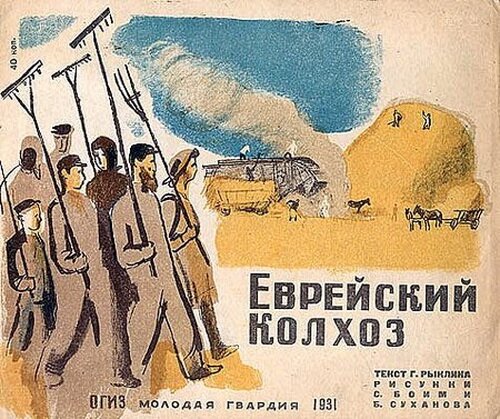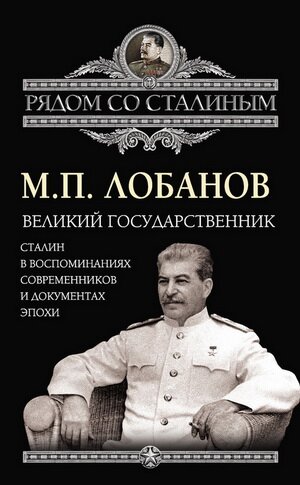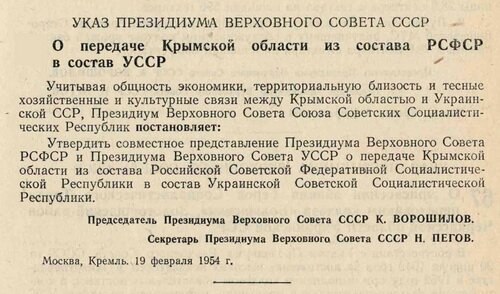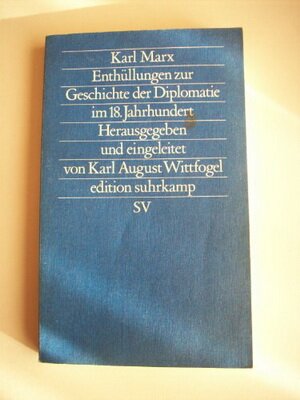
The Independent Analytical Center for Geopolitical Studies “Borysfen Intel” affords ground to the analysts generation for expressing their point of view regarding the political, economic, security, information situation in Ukraine and in the world in general, according to their personal geopolitical studies and analyses.
Note that an authors’ point of view
|
Valeriy Shvets, Professor
Ukraine. Crimea. Russia. Part 1.
Ukraine — Crimea — Russia. Part 2
Ukraine and the Crimea were overwhelmed by a wave of bloody Bolshevik terror, which got especially intensified when November 14, 1920 the last steamer with Wrangel's army servicemen set sail from the Peninsula. The Crimea became completely red. Note that at that time there remained many military servicemen and civil employees, who believed in the amnesty declared by the Soviet government. November 17, 1920 the Crimean Revolutionary Committee issued a decree on compulsory, within three days, registration of foreigners, persons who arrived in the Crimea in the absence of Soviet power there, officers, civil servants and soldiers of Wrangel's army. Soon all the promises about amnesty were forgotten. Those who did not get registered and those who did get registered were shot. On the whole, were shot tens of thousands of citizens. Different authors mention numbers from 50 to 120 thousand. Currently they agree on 96 thousand. In fact, at that moment began the hunt for intellectuals regardless of their occupation. According to the famous Russian poet Maximilian Voloshin, out of every three intellectuals survived one.
Like the Famine-Genocide of 1930s, the famine of 1921-1923 was the result of misanthropic policy of the Soviet leadership. Summer 1921 in the Crimea was dry. Note that the drought in one of the regions of any country is never a cause of hunger in the region. The country is there to help one region at the expense of others at a critical moment. In the Crimea, it was different. One of the main reasons for the upcoming disaster was the state of emergency introduced in the Crimea immediately after the arrival of Bolsheviks in autumn of 1920, when the population was forbidden to leave the domicile. This, in fact, doomed it to death.

About what the diet was like at the time, we can judge from the Registration Card of the teacher of the 4th Soviet school of Yevpatoriya Vera Nikitichna Afanaseva, issued to her in October 1921. Her labor ration was as foollows: 3/4 pound of bread (1p = 450grams), 1/2 p of sugar, 1 p of salt and 10 pounds of vegetables
http://kfinkelshteyn.narod.ru/
Only February 16, 1922, when tens of thousands had already died, at a meeting of VTsiK the Crimea was recognized the areas experiencing famine. But even then the RSFSR People's Commissariat of Food set for the Crimean village a food tax — 1.2 million tons of grain. That is, it was necessary to give away all the grown grain. Moreover, the peasants were even forbidden to sow fields as the seed corn also was being taken away. In those years there were many reports of suicide and mass cannibalism because of famine. Salted meat of children was found everywhere. In Karasubazar the militia found a stock of 17 salted corpses, mostly children. February 18, 1922 “Pravda” reported, “...In the Crimea: has been completely eaten all the cattle and horses, the rural population is leaving its homes and rushing to cities, the mortality rate is progressing. On highways Sevastopol — Simferopol — Yevpatoria, in cities, on the streets and near railway stations are lying corpses... and children abandoned by mothers”. In different parts of the city of Sevastopol, — was reported in the daily news of NC on February 18, 1922 — lie corpses that are not being taken away for up to two days. Local people passing by send curse to Soviet power. The dead are buried without registration and ceremony”. In the summer of 1923 the number of deaths from starvation in the Peninsula exceeded 100 thousand people.

The first fact of mass famine occurred in Ukraine in 1921-1923
http://obozrevatel.com/
The artificially created famine of 1921-1923 had truly disastrous results for the Crimea. The Peninsula's population decreased from 719 531 to 569 580 people. But before 1921 the Crimea had already lost about one hundred thousand people. Many settlements were deserted. In Karasubazar the population decreased by 48%, in the Old Crimea — by 40.8 %, in Feodosia — by 35.7 %, in Sudak district — by 36%. Lots of inhabited by the Crimean Tatars mountain villages died out completely. Most of all in the Crimea suffered Tatars and Ukrainian peasants. To the extent to which the process of the destruction of Crimeans could be handled, it focused on the extinction of Ukrainians and Crimean Tatars. The famine in the Crimea can be called a dress rehearsal for the famine of 1932-1933 in all of Ukraine and the Crimea — a Red Terror laboratory for the same Ukraine and beyond. Physical isolation of the Crimea from the country, information blockade, and high concentration of troops, the state of emergency and the KGB terror had become a valuable experience for further use throughout Ukraine. At the first stage — destruction of the intelligentsia and demoralization of the rest of the population, and then the ax of proletarian terror already cuts at the very root of the human society — the peasantry.
|
|
The Crimea has always been an idyllic dream of a Russian soul. Apparently, for the people living in the harsh climate of the north on the barren and inhospitable land, where the horizon is always limited to the tops of nearby trees, the Crimea seemed a paradise: the warm climate, fertile land, steppe areas and warm sea around. For more than three hundred years Russia again and again was trying to colonize the Crimean land, but for organic inhabitants of this land and the invaders themselves it brings nothing but grief.
Between the two world wars, the Crimea learned what stagnation is about. There has been no progress at all. Punitive actions of early 1950s were so effective that nothing else was needed. The Famine-Genocide of 1932-1933 hardly touched the Crimea. Punitive organs monitored primarily to ensure that food was not exported from the Crimea to the neighboring regions of Ukraine, as the Peninsula belonged to the Russian Federation and, as they believed then, forever. But there was another game played around the Crimea.
It is known that Jewish nationalists played one of the leading roles in the implementation of the proletarian revolution in the Russian Empire. They dreamed about many things, including their own ethnic state, or at least an autonomous entity within the country. One such attractive option was seen by international Jewish movement in the creation if not of an independent state, then at least of an autonomous republic in the Crimea within the Soviet Union.

One of the prominent members of the Soviet government Y. Larin (Lurie) developed a plan to establish Jewish autonomy in the Crimea and settlements on its territory - to create a majority in the area of 280.000 Jews. In November 1923 there was also another project, the author of which was the Head of the Jewish section of the CPSU A. Bragin, who suggested formation of Jewish autonomous region in northern Crimea, southern steppe zone of Ukraine and at the Black Sea coast up to the borders of Abkhazia

http://blog.i.ua/
Before the revolution, Jews in southern Ukraine and northern Crimea owned up to 1 million 200 thousand hectares of land, including 208 thousand in the Crimean Peninsula. Positive about this idea was almost all the ruling elite of the Soviet Union. Stalin was carrying out a complicated game with international Jewish organizations. After all, he needed their material and information support, which he was receiving almost all his life. However, in reality, nothing came out of that idea. According to the 1926 census, the ethnic composition of the Crimea was as follows. The Crimean population (together with Sevastopol ) was 713.8 thousand (three times less than the current): Russians — 301.4 thousand (42.2 %), Tatars — 179,1 thousand (25.1 %), Ukrainians — 77.4 thousand (10.8 %), Germans — 43.6 thousand (6.1 % ), Jews — 39.9 thousand (5.6 %), Greeks — 16.0 thousand (2.3 %), Bulgarians — 11.4 thousand (1.6 % ), Armenians — 10.7 thousand (1.5 %), the Crimean Jews — 6.0 thousand (0.8 %), Karaimes — 4.2 thousand (0.6 %). Despite the great efforts of the central government, the percentage of Jewish population in the Crimea remained insignificant. Crimean Tatars actively opposed the Jewish colonization of the Peninsula. And they were those who experienced the force of the next powerful strike of the repressive apparatus of modern Russian Empire.
But before this was the German occupation of the Crimea. It was not much different from the occupation of other Ukrainian lands. The difference was in that the Germans were not able to resist the temptation to publicly dream about the future of the Crimea as of purely German land with predominantly German population. For objective reasons, these dreams were short-lived. In 1944, the Third Reich was replaced in the Peninsula again with the Modern Russian Empire, and with it revived the dream of the Russian Crimea. First, in May 1944, from the Crimean territory were evicted 183.155 Crimean Tatars (excluding soldiers who were sent to special settlement after demobilization in 1945). But it did not stop there. In June 1944, were evicted Crimean Armenians, Bulgarians, Czechs and Greeks. All in all were evicted at least 300 thousand people. The number of the Crimean population again decreased to about half a million. The reason was the charge of the Crimean Tatars and other peoples in aiding German occupiers. For the most part this charge would have to touch especially Russians because a lot of them served in the Wehrmacht and the SS. After all, at the divisional level alone in the German Armed Forces were 27 purely Russian or mixed Russian-German personnel of divisions. But who had the courage to stand up for the Crimean Tatars? And who could stand up for Ukrainians throughout Ukraine, against whom there was a similar order about deportation, for some reason never fulfilled?
The twentieth century was the century of nationalism. In this regard almost all European nations, Jews included, showed their desire for self-actualization within their state (e.g. Ukrainians, Jews, Poles, etc.), or within their own empire (Germans, Russians, Italians).
In Russia intertwined the world's largest national contradictions. Powerful Jewish nationalism proved dangerous for the classical Russian Empire while, in fact, the Russian nationalism in the early twentieth century was just starting to gain strength. In the vastness of the former Russian Empire, the leading, so to say, players were Jews and Russians. Stalin was flirting with both these nations. In 1920s and 1930s, during the preparations for the Second World War (World Revolution), Stalin prefered Jews. In this light becomes clear his acquiescence in the issue of establishment of a Jewish autonomy in the Crimea. In the late 1930s, he felt strong enough to lead his policy. In 1937, on the eve of the crucial international events, he made a total purge of the state apparatus of the Soviet Union, including the Army and punitive bodies, in order to make them absolutely submissive and showing unwillingness to share power within the country with any international Jewish organizations. From that time until his death, Stalin professed Russian nationalism. The most affected party this time was Jews. They were destroyed by hundreds of thousands, most of whom during and after the revolution massively joined government bodies. The Ukrainian nationalism in 1937 was out of the question, because its remains had been exterminated. Now the Crimean problem had to be treated based on the interests of the Russian ethnos. A “Great Russian statesman”- so said about Stalin a famous contemporary Russian writer.

Mikhail Lobanov: Great statesman. Stalin in the memoirs of contemporaries and documents of the era (2013)
http://www.ex.ua/
After the Second World War, Stalin used the Crimean issue in yet another attack on Soviet Jewry. Repressions against the initiators and leaders of creating a Jewish autonomous republic in the Crimea began in 1948 after the assassination of the People's Artist of the USSR, laureate of Stalin Prize S. Mikhoels and ended in 1952 in the dungeons of the Lubyanka with the execution of several prominent Jewish writers, actors and other intellectuals. The Crimea became Russian definitively, without any other encroachments.
Since the end of the war until the transfer of the Crimea to Ukraine, its state was pathetic. The first wave of immigrants to the Peninsula from the deep regions of Russia did not have the expected effects. Russians from wooded Russian areas found it difficult to get used to the steppe and could not get adapted to the mountainous terrain. Gardens, grapes, ether-bearing plants, tobacco, industrial crops, even corn were seen by Russian settlers for the first time in their life. Besides, crop acres decreased significantly. In 1913, the average yield of grain crops on the Crimean land was 11.2 centners/Ha, in 1940 — 10.7, and in 1950 — 3.9 centners/Ha. The number of cattle also was reduced. In 1950 (as compared with 1940) the Crimea almost 5 times reduced the sale of grain, three times — tobacco, twice — vegetables, almost 5.5 times — potatoes, five times — ether-bearing plants, almost two times — grapes, 2.5 times — wool. Even after ten years after the war in the Crimea vegetable growing had not reached the pre-war figures and could not meet the needs of the local population. Orientation of the regional administration for the resumption of labor resources in the region due to immigrants from Russia proved futile. Even when the Crimea was part of the RSFSR, it became clear that in this capricious nature-climatic region can take root only that population in whose blood there is the steppe agricultural culture. Question about re-subordination of the Crimean region was ideologically and economically justified at the devoted to agricultural issues September Plenum of the CPSU Central Committee in 1953, where Nikita Khrushchov, an absolute expert in agriculture made a fundamental report. That's when he was elected First Secretary of the CPSU Central Committee while Chairman of the Presidium of the Central Committee and Chairman of the Council of Ministers remained G. Malenkov.
From Alexei Adzhubey's (Khrushchov's son-in-law) memoirs we know that shortly after the Plenum Khrushchev visited the Crimea. According to Adzhubey, most of all N. Khrushchov was shocked, angered and outraged by noisy crowds of Russian immigrants, torpedoing the First Secretary's car. They complained of unbearable living conditions, of poor housing and lack of food. “It is only now I write “came”- points out A. Adzhubey — but they shouted “we were driven”. From the crowd were heard quite hysterical cries: “Here potato does not grow, cabbage wilts”. Or very sad ones like “Bedbugs have seized”.

“Southerners are needed there, who love gardens, corn, not potato”- kept persuading Khrushchov
http://russian7.ru/
According to Alexei Adzhubey, N. Khrushchov on the same day went to Kiev, where he had a long talk with the leadership of the republic. Using his authority among the leadership in Kiev, Nikita Sergeyevich urged Ukrainians to help revive the Crimean land. “Southerners are needed there, who love gardens, corn, not potato”- kept persuading Khrushchov. The decision to transfer the Crimean region of the RSFSR to the Ukrainian SSR was a product of the collective opinion of the senior party leadership and the Soviet government. Without the participation of the old Stalinist guards — Malenkov, Molotov, Kaganovich, Voroshilov, and Bulganin — that decision would not have been taken. Khrushchev's positions in the party and state at the time were not strong enough for him to solely decide on the fate of such a strategically important region, as the Crimea. Officially the Crimea was transferred to Ukraine by Malenkov's decree, and that decree of the Presidium of the Supreme Soviet of the USSR was also signed by K. Voroshilov.

1954 - the Crimea is transferred from Russia to Ukraine. Despite the fact that Sevastopol since 1948 was not part of the Crimean region, having received a special status in Russia, due to legal uncertainties, it was transferred to Ukraine together with the Crimea
http://kykyryzo.ru/
The country's top leadership's having a special program is evidenced by the information stamped “Secret” “About the state of agriculture in the Crimean region” of January 4, 1954, which was prepared for the First Secretary of the Central Committee of the Communist Party of Ukraine A. Kirichenko. This document in a compressed form and without ideological fireworks reflected the real, catastrophic state of agriculture and profound neglect of the social sphere of the Crimea on the eve of its being transferred to Ukraine. In the Peninsula at the end of 1953 there were only 3 baker's shops, 18 butcher's shops, 8 dairy shops, 2 shops selling fabrics, 9 footwear shops, 5 shops selling building materials and 28 bookshops. Based on the data, let us ask ourselves the question: was the transfer of the Crimean region to the Ukrainian SSR a “generous gift” or rather an economic yoke?
I think that one more important reason for the transfer of the Crimean Peninsula to Ukraine was the Russian Federation's attempt to get rid of the load of secret promises and agreements that had accumulated since the Stalin era before international Jewish organizations. The transfer of the Crimea needed some ideological ground, which became the jubilee — the 300th anniversary of Pereyaslavska Rada (the Council of Pereyaslav). Propaganda machine of both, the Tsarist and Bolshevik empire filed this event as a reunion of Ukraine and Russia. It was decided to celebrate it noisily at the state level. The transfer of the Crimean region to Ukraine on the eve of the grand celebration of “eternal friendship between the two fraternal peoples” fitted perfectly well into the Kremlin's scenario.
But without any pomposity from Ukraine to Russia (Minutes of the Presidium of the CPSU Central Committee number 49 of January 25, 1954) instead was transferred Taganrog and adjoining lands, — the area much larger than the Peninsula in the Black Sea and with a much larger population. That is, instead of the rich black soil regions, Ukraine received arid saline steppe without water, without a hint on irrigation, without electricity and energy carriers. Instead of Ukrainian population Ukraine received the Russian one, most of which have never become loyal to the Ukrainian state. I remember my planned sanatorium meetings with the Doctor-therapist at Livadia sanatorium. Instead of medical, he for some reason tried to discuss with me issues of self-determination of the Russians. “We will take up arms”- I repeatedly heard from him. In 2005, it sounded nonsense to me. Now we can see it all in reality.
Ukraine did have territorial losses before. In 1924 the RSFSR put forward before the Central Committee of the Russian Communist Party (of Bolsheviks) groundless claims for Shahtinskii and Taganrog districts (total area of 5 thousand square kilometers of Donetsk region, where Ukrainians constituted 71.5 % of the population, and in 1925 by the Decree “On the regulation of the border with the Russian Federation and BSSR”, large areas of land of Chernihiv, Kursk and Voronezh regions, where Ukrainians also constituted an absolute majority, were annexed to Russia. In 1920s were revised borders of the Ukrainian SSR and large ethnic Ukrainian territories were cut off for the benefit of the RSFSR. By the Decree of the Presidium of VTsiK from 06/03/1924, as part of the Ukrainian SSR was created Moldavian ASSR, which included part of the Ukrainian ethnic lands (existed prior to 02.08.1940). After the foundation of the Moldavian SSR, part of these lands remained in its composition. Now they are called Trans-Dniester Republic. Look at the map of Ukraine of Hetman P. Skoropadskyi's times. There you can clearly see all that we had lost during the Soviet era. Now, in the twenty-first century, they are trying to take away the Crimea, of which (for the situation to look especially funny) they first with much fanfare state that we were “presented “with it in 1954.

The map of Ukraine of Hetman Skoropadskyi's times
http://argumentua.com/
|
|
Friedrich Nietzsche once said, “Everything that does not kill me makes me stronger”. But in the nearest future we need to make sure — whether our shameful defeat in the Crimea will make us stronger, or will it drive in the so-called fatal nail into the coffin of the Ukrainian nation. Dmitriy Dontsov believed that every nation is divided into Cossacks and swineherds. Again we must soon find out — are there among Ukrainians enough of true Cossacks, or are there only swineherds? Apathetic response of the Ukrainian community to the events in the Crimea and in Eastern Ukraine shows not our love for peace, but our weakness that only encourages Russia to further aggressive actions against Ukraine.
At the end of these lines it would be appropriate to quote a man known to the older generation of Ukrainians.

The known Karl Marx' evidence in his work "Enthüllungen über die Geschichte der Diplomatie des 18 Jahrhunderts"
http://vk.com/
”In the bloody swamp of Moscow slavery and not in the harsh glory of the Norman era stands the cradle of Russia. Changing names and dates, we will see that the policy of Ivan III and the policy of the modern Moscow empire are not just similar, but identical. Russia was born and brought up in ugly and humiliated school of Mongolian slavery. It became strong only thanks to its unmatched skills in the art of slavery. Even when Russia became independent, it continued to be a country of slaves. Peter I joined the political cunning Mongol slave with greatness Mongolian owner who bequeathed Genghis Khan to conquer the world. Politics Russia — remains unchanged. Russian methods and tactics have changed, and will change, but the leading star of the Russian policy — to conquer the world and rule it — is and will remain unchanged. Moscow’s pan-Slavism is just one form of Moscow's conquest”. (Karl Marx. http://censor.net.ua/f480436).

